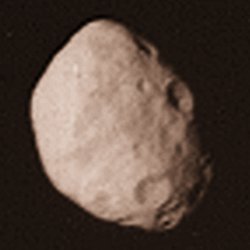Janus (moon)
|
|

| |
| Discovery | |
|---|---|
| Discovered by | Audouin Dollfus |
| Discovered in | December 15, 1966 |
| Orbital characteristics | |
| Semimajor axis | 151,472 km [1] (http://sse.jpl.nasa.gov/planets/profile.cfm?Object=Sat_Janus&Display=Facts) |
| Eccentricity | 0.007 |
| Orbital period | 0.6959 d |
| Inclination [2] (http://www.hnsky.org/iau-iag.htm) | 0.20° (to Saturn's equator) |
| Is a satellite of | Saturn |
| Physical characteristics | |
| Diameter | 194×190×154 km |
| Mass | 1.98×1018 kg |
| Mean density | 0.65 g/cm3 |
| Surface gravity | ~0.017 m/s2 |
| Rotation period | synchronous |
| Axial tilt | zero |
| Albedo | 0.5 |
| Atmosphere | none |
Janus (jay'-nus, Greek Ιανός) is a moon of Saturn. It is also known as Saturn X (Roman numeral X = 10). It is named after the mythological Janus.
| Contents |
Discovery and orbit
Janus occupies essentially the same orbit as the moon Epimetheus. Astronomers assumed that there was only one body in that orbit, and accordingly had a hard time figuring out their orbital characteristics; it is obviously impossible to reconcile the observations of two distinct objects as a single object.
The discovery of Janus is attributed to its first observer: Audouin Dollfus, on December 15 1966 (IAUC 1987 (http://cfa-www.harvard.edu/iauc/01900/01987.html#Item1)). The new object was given the temporary designation S/1966 S 2. Shortly before, Jean Texereau had photographed Janus on October 29 1966 without realising it (IAUC 1995 (http://cfa-www.harvard.edu/iauc/01900/01995.html)). On December 18, Richard L. Walker made a similar observation which is now credited as the discovery of Epimetheus (IAUC 1991 (http://cfa-www.harvard.edu/iauc/01900/01991.html#Item2)). Twelve years later, in October 1978, Stephen M. Larson and John W. Fountain realised that the 1966 observations were best explained by two distinct objects (Janus and Epimetheus) sharing very similar orbits. See Epimetheus' article for a more detailed description of their unique arrangement.
Janus was also observed by the Pioneer 11 probe when it passed near Saturn on September 1 1979: three energetic particle detectors observed its "shadow" (S/1979 S 2, Tom Gehrels and James A. van Allen, IAUC 3417 (http://cfa-www.harvard.edu/iauc/03400/03417.html#Item1)). Janus was observed by Dan Pascu on February 19 1980 (S/1980 S 1, IAUC 3454 (http://cfa-www.harvard.edu/iauc/03400/03454.html#Item1)), and then by John W. Fountain, Stephen M. Larson, Harold J. Reitsema and Bradford A. Smith on the 23rd (S/1980 S 2, IAUC 3456 (http://cfa-www.harvard.edu/iauc/03400/03456.html#Item3)). The Voyager 1 probe finally confirmed Janus' existence on March 1 1980. All of these people thus share, to various degrees, the title of discoverer of Janus.
Although the name "Janus" was informally proposed soon after the initial 1966 discovery, it was not officially given this name until 1983. Epimetheus received its name at the same time.
For more information about Janus and Epimetheus' unusual shared orbit, see Epimetheus.
Physical characteristics
Janus_Cassini.jpg
Janus is extensively cratered with several craters larger than 30 km but few linear features. The Janian surface appears to be older than Prometheus' but younger than Pandora's. From its very low density and relatively high albedo, it seems likely that Janus is a very porous icy body. There is a lot of uncertainty in these values, however, and so this remains to be confirmed.
See also
External links
- The Planetary Society: Janus (http://www.planetary.org/saturn/janus.html)
| Saturn's natural satellites |
|---|
| Janus' group | Mimas | Enceladus | Tethys | Dione | Rhea | Titan | Hyperion | Iapetus | Inuit group | Gallic group | Norse group |
fr:Janus (lune) nl:Janus (maan) ru:Янус (спутник Сатурна) sk:Janus (mesiac) zh:土卫十
